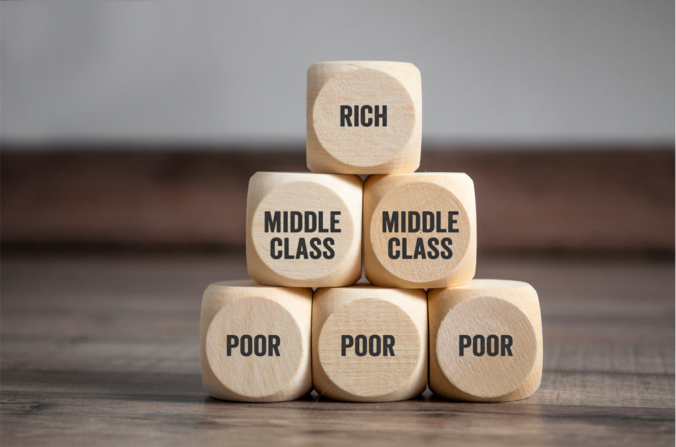During the past 50 years in the U.S., the number of rich people has grown and gotten richer, the middle class has shrunk, and the percentage of Americans in the lower-income tier has gone up.
That’s according to new analysis by Pew Research Center that found between 1971 and 2021, the percentage of Americans in the middle-income tier fell from 61% to 50% as the percentage in the lower- and upper-income tiers grew.

Who’s in the middle class?
The survey defined middle class as an annual income between about $52,000 to $156,000 for a household of three, or between two-thirds to double the national median income in 2020 after being adjusted for household size.
A household of three making less than $52,000 was classified as lower income and those making more than $156,000 were classified as upper income.
The salary it takes to be middle class depends on where you live and how big your household is. A household of five making $52,000, for example, wouldn’t make enough to classify as middle income in Salt Lake City, according to Pew’s income calculator.
The rich are getting richer
While the middle class once held a majority of the aggregate income in the U.S., that distinction now goes to the richest Americans. Pew found the percentage of the aggregate household income held by upper-income Americans skyrocketed from 29% in 1970 to 50% in 2020 as the middle class fell from 62% to 42%.

The trend is due to the growing percentage of Americans in the upper-income tier, but the group has also seen the biggest financial gains. While all income groups have seen their median income grow over the past half century, the richest Americans saw it grow the most, with a 69% increase between 1970 and 2020, compared to 50% growth for middle-income Americans.
The pandemic
Though these trends have been decades in the making, the COVID-19 pandemic only exacerbated conditions for many in the middle- and lower-income tiers.
Those in the middle- and lower-income brackets were more likely than those in the upper-income group to experience unemployment at least some of the time in 2020, and they also saw a larger drop in household income between 2019 and 2020, according to Pew.
Being middle class is more than just salary, though, it’s a mindset. A 2015 Pew poll found 87% of Americans consider themselves middle class, including 34% of those who made $100,000 or more and consider themselves upper-middle class. Just 6% who made $100,000 or more self-identified as upper class.
